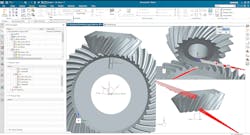New Release Extends Mechanical Performance Prediction
SIEMENS DIGITAL INDUSTRIES SOFTWARE released the latest update to Simcenter™ 3D software, part of its Xcelerator portfolio of software and services. It helps engineers address the complexity of product development with advanced simulation. Among the new capabilities, Simcenter 3D offers increased support for turbomachinery modeling, a dedicated drop-test application for handheld devices, tightly integrated topology optimization with the NX Design environment, and a new acoustic solution method that is up to 10X faster than standard methods.
“This release of Simcenter 3D brings together our combined expertise and experience across a wide range of industry sectors, capabilities and physics,” stated Willy Bakkers, v.p. of solution domain product management, simulation and test division at Siemens.
Siemens’ Simcenter 3D 2022.1 release focuses on four areas:
Model the complexity: The ability to model and understand complex physical phenomena is at the forefront of this Simcenter 3D release. Simcenter 3D’s solution for the turbomachinery industry has been extended with additional thermal multiphysics, rotordynamics and thermal fatigue capabilities to more accurately capture the complex physics happening within these machines. A new dedicated set of tools to simulate spiral bevel gears, as often found in automotive differentials, enables accurate, system-level NVH analysis on these mechanisms to reduce gear whine. Additionally, a new dedicated application simplifies and streamlines the drop-test simulation process for electronic and other handheld devices for engineers who are not simulation experts.
Explore the possibilities: Acoustics auralization capabilities allow engineers to simulate and listen to the acoustics/sound within the context of the end-user’s experience. Engineers can mix all contributing sounds and listen to the combined acoustics results to answer questions, such as “What will a loudspeaker sound like when you put it in a car and combine it with background noise from the engine, HVAC, wind and road?”
In this release, topology optimization is now more tightly integrated with the NX Design environment so that simulations are ‘replayable’ and become easier for designers to create lightweight, yet structurally capable designs.
Go faster: Two core updates enable our customers to break new ground more quickly than ever before. The new high-performance boundary element method with adaptive order solution (BEMAO) used for acoustics simulation is up to 10 times faster compared to the standard boundary element method, while new load case filtering for aerostructures allows engineers to quickly determine the final critical list of load cases from the thousands of load cases experienced in an airframe.
Stay integrated: Simcenter 3D now connects with Xcelerator Share for Xcelerator as a Service (or XaaS) subscribers. The Xcelerator Share collaborative cloud environment helps users or distributed workgroups seamlessly share files and communicate results to aid ad-hoc collaboration.
Finally, engineers can now launch simulations remotely to any workstation or HPC cluster right from their desktop.
Learn more at siemens.com/simcenter
